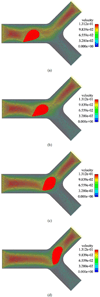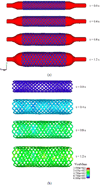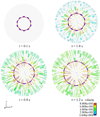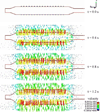Modeling of Soft Tissues Interacting with Fluid (Blood or Air) Using the Immersed Finite Element Method
- PMID: 26855688
- PMCID: PMC4743898
- DOI: 10.4236/jbise.2014.73018
Modeling of Soft Tissues Interacting with Fluid (Blood or Air) Using the Immersed Finite Element Method
Abstract
This paper presents some biomedical applications that involve fluid-structure interactions which are simulated using the Immersed Finite Element Method (IFEM). Here, we first review the original and enhanced IFEM methods that are suitable to model incompressible or compressible fluid that can have densities that are significantly lower than the solid, such as air. Then, three biomedical applications are studied using the IFEM. Each of the applications may require a specific set of IFEM formulation for its respective numerical stability and accuracy due to the disparities between the fluid and the solid. We show that these biomedical applications require a fully-coupled and stable numerical technique in order to produce meaningful results.
Keywords: Biomechanics; Fluid-Structure Interactions.
Figures


















Similar articles
-
Modified Immersed Finite Element Method For Fully-Coupled Fluid-Structure Interations.Comput Methods Appl Mech Eng. 2013 Dec 1;267:10.1016/j.cma.2013.07.019. doi: 10.1016/j.cma.2013.07.019. Comput Methods Appl Mech Eng. 2013. PMID: 24223445 Free PMC article.
-
Immersed finite element method and its applications to biological systems.Comput Methods Appl Mech Eng. 2006 Feb 15;195(13-16):1722-1749. doi: 10.1016/j.cma.2005.05.049. Comput Methods Appl Mech Eng. 2006. PMID: 20200602 Free PMC article.
-
Finite element methods for the biomechanics of soft hydrated tissues: nonlinear analysis and adaptive control of meshes.Crit Rev Biomed Eng. 1992;20(3-4):279-313. Crit Rev Biomed Eng. 1992. PMID: 1478094
-
Finite element models of the human shoulder complex: a review of their clinical implications and modelling techniques.Int J Numer Method Biomed Eng. 2017 Feb;33(2):e02777. doi: 10.1002/cnm.2777. Epub 2016 Mar 22. Int J Numer Method Biomed Eng. 2017. PMID: 26891250 Free PMC article. Review.
-
Computational performance of Free Mesh Method applied to continuum mechanics problems.Proc Jpn Acad Ser B Phys Biol Sci. 2011;87(4):135-51. doi: 10.2183/pjab.87.135. Proc Jpn Acad Ser B Phys Biol Sci. 2011. PMID: 21558753 Free PMC article. Review.
Cited by
-
The Perfectly Matched Layer absorbing boundary for fluid-structure interactions using the Immersed Finite Element Method.J Fluids Struct. 2018 Jan;76:135-152. doi: 10.1016/j.jfluidstructs.2017.09.002. J Fluids Struct. 2018. PMID: 29151673 Free PMC article.
-
Evaluation of aerodynamic characteristics of a coupled fluid-structure system using generalized Bernoulli's principle: An application to vocal folds vibration.J Coupled Syst Multiscale Dyn. 2016 Dec;4(4):241-250. doi: 10.1166/jcsmd.2016.1114. Epub 2016 Dec 1. J Coupled Syst Multiscale Dyn. 2016. PMID: 29527541 Free PMC article.
-
Cerebrospinal Fluid Cavitation as a Mechanism of Blast-Induced Traumatic Brain Injury: A Review of Current Debates, Methods, and Findings.Front Neurol. 2021 Mar 12;12:626393. doi: 10.3389/fneur.2021.626393. eCollection 2021. Front Neurol. 2021. PMID: 33776887 Free PMC article. Review.
-
Immersed Boundary Models for Quantifying Flow-Induced Mechanical Stimuli on Stem Cells Seeded on 3D Scaffolds in Perfusion Bioreactors.PLoS Comput Biol. 2016 Sep 22;12(9):e1005108. doi: 10.1371/journal.pcbi.1005108. eCollection 2016 Sep. PLoS Comput Biol. 2016. PMID: 27658116 Free PMC article.
-
Fully-coupled aeroelastic simulation with fluid compressibility - For application to vocal fold vibration.Comput Methods Appl Mech Eng. 2017 Mar 1;315:584-606. doi: 10.1016/j.cma.2016.11.010. Epub 2016 Oct 17. Comput Methods Appl Mech Eng. 2017. PMID: 29527067 Free PMC article.
References
-
- Peskin C. Numerical analysis of blood flow in the heart. Journal of Computational Physics. 1977;25:220–252. http://dx.doi.org/10.1016/0021-9991(77)90100-0. - DOI
-
- McCracken M, Peskin C. A vortex method for blood flow through heart valves. Journal of Computational Physics. 1980;35:183–205. http://dx.doi.org/10.1016/0021-9991(80)90085-6. - DOI
-
- McQueen D, Peskin C. Computer-assisted design of pivoting-disc prosthetic mitral valves. Journal of Computational Physics. 1983;86:126–135. - PubMed
-
- Peskin C, McQueen D. A three-dimensional computational method for blood flow in the heart. I. Immersed elastic fibers in a viscous incompressible fluid. Journal of Computational Physics. 1989;81:372–405. http://dx.doi.org/10.1016/0021-9991(89)90213-1. - DOI
-
- Peskin C, McQueen D. Cardiac fluid dynamics. Critical Reviews in Biomedical Engineering, SIAM Journal on Scientific and Statistical Computing. 1992;20:451–459. - PubMed
Grants and funding
LinkOut - more resources
Full Text Sources
Other Literature Sources
